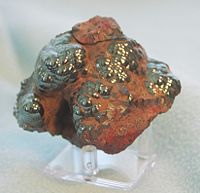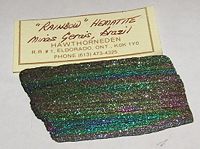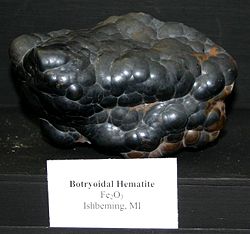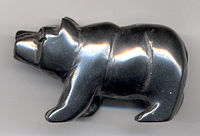Hematite
| Hematite | |
|---|---|
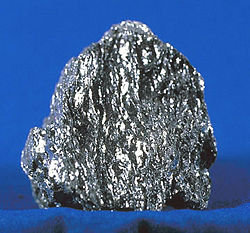 |
|
| General | |
| Category | Mineral |
| Chemical formula | iron(III) oxide, Fe2O3, α-Fe2O3 |
| Identification | |
| Color | Metallic grey to earthy red |
| Crystal habit | Tabular to thick crystals |
| Crystal system | Hexagonal (rhombohedral) |
| Cleavage | None |
| Fracture | Uneven to sub-conchoidal |
| Mohs Scale hardness | 5.5 - 6.5 |
| Luster | Metallic to splendent |
| Refractive index | Opaque |
| Pleochroism | None |
| Streak | Bright red to dark red |
| Specific gravity | 4.9 - 5.3 |
Hematite (AE) or haematite (BE) is the mineral form of Iron(III) oxide, (Fe2O3), one of several iron oxides. Hematite crystallizes in the rhombohedral system, and it has the same crystal structure as ilmenite and as corundum. Hematite and ilmenite form a complete solid solution at temperatures above 950°C.
Hematite is a very common mineral, coloured black to steel or silver-gray, brown to reddish brown, or red. It is mined as the main ore of iron. Varieties include kidney ore, martite (pseudomorphs after magnetite), iron rose and specularite (specular hematite). While the forms of hematite vary, they all have a rust-red streak. Hematite is harder than pure iron, but much more brittle.
Huge deposits of hematite are found in banded iron formations. Grey hematite is typically found in places where there has been standing water or mineral hot springs, such as those in Yellowstone. The mineral can precipitate out of water and collect in layers at the bottom of a lake, spring, or other standing water. But, hematite can also occur without water, as the result of volcanic activity.
Clay-sized hematite crystals can also occur as a secondary mineral formed by weathering processes in soil, and along with other iron oxides or oxyhydroxides such as goethite, is responsible for the red color of many tropical, ancient, or otherwise highly weathered soils.
The name hematite is derived from the Greek word for blood (haima), since sometimes hematite can be red, as in Rouge, a powderized form of hematite. It shares this root with the word hemoglobin. Hemoglobin is the oxygen-transporting molecule in red blood cells, the iron of which causes blood to be red. The color of hematite lends it well in use as a pigment.
Especially good specimens of hematite come from England, Mexico, Brazil, Australia and the Lake Superior region of the United States and Canada.
Hematite is an antiferromagnetic material below the Morin transition at 260K, and a canted antiferromagnet or weakly ferromagnetic [1] above the Morin transition and below its Néel temperature at 948K, above which it is paramagnetic.
Hematite is part of a complex solid solution oxyhydoxide system having various degrees of water, hydroxyl group, and vacancy substitutions that affect the mineral's magnetic and crystal chemical properties.[1] Two other end-members are referred to as protohematite and hydrohematite.
Hematite in popular culture
Since polished hematite is considered by many to be a gemstone, it has been used in jewelry over the course of the last 50 years in North America, especially in the western United States. Its use in jewelry reached a height in Europe in Victorian times when it was very popular. Hematite can be found used in jewelry and art created by the Native Americans.
See also
- Iron ore
- Iron oxide
- List of minerals
- Wüstite
- Magnetite
- Mineral redox buffer
- Opportunity Mars Rover
ReferencesISBN links support NWE through referral fees
- ↑ M.-Z. Dang, D.G. Rancourt, J.E. Dutrizac, G. Lamarche, and R. Provencher. Interplay of Surface Conditions, Particle Size, Stoichiometry, Cell Parameters, and Magnetism in Synthetic Hematite-like Materials. Hyperfine Interactions 117 (1998) 271-319.
- Webmineral data
- Mindat mineral data
- Martite - Mindat w/ location data
- Iron rose - Mindat w/ locations
External links
- Abandoned Mine Research.
- Mars spheres image.
- Mars trench image showing a shiny texture of half-buried spheres (dark line is equipment shadow)
- Florence Mine, Cumbria, UK.
ca:Hematites cs:Hematit de:Hämatit et:Hematiit es:Hematita eo:Hematito fr:Hématite it:Ematite he:המטיט lt:Hematitas hu:Hematit nl:Hematiet ja:赤鉄鉱 no:Hematitt pl:Hematyt pt:Hematita ru:Гематит simple:Hematite sk:Hematit fi:Hematiitti sv:Hematit
